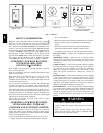
2
OFF HIGHLOW
ARRET HAUTEBASSE
% D HUMIDITE RELATIVE HUMIDITY
20
25
30
40
50
60
70
80
OFF
ARRET
LOW
BASSE
INTERMITTENT
AIR EXCHANGE
ECHANGE D´AIR
´
ON
MARCHE
% HUM. RELATIVE HUM.
55%
45%
35%
30%
EXT. TEMP. EXT.
% D´HUMIDITE RELATIVE HUMIDITY
´
% HUM. RELATIVE HUM.
55%
45%
35%
30%
EXT. TEMP. EXT.
MODE
AIR EXCHANGE
ECHANGE D´AIR
´
20
25
30
40
50
60
70
80
10°C/50°F
0°C/32°F
–10°C/14°F
–20°C/–4°F
´
´
10°C/50°F
0°C/32°F
–10°C/14°F
–20°C/–4°F
OneTouch
TM
Control
Basic Control
Standard Control Automatic Control
(Not compatible with the following series:
HRVCCSHB and HRVCCSVB)
INTERMITTENT
MAX
MIN
A10003
Fig. 2 -- Controls
SAFETY CONSIDERATIONS
Recognize safety information. This is the safety--alert symbol
When you see this symbol on the unit and in instructions or
manuals, be alert to the potential for personal injury. Understand
these signal words; DANGER, WARNING, and CAUTION. These
words are used with the safety--alert symbol. DANGER identifies
the most serious hazards which will result in severe personal injury
or death. WARNING signifies hazards which could result in
personal injury or death. CAUTION is used to identify unsafe
practices which would result in minor personal injury or product
and property damage. NOTE is used to highlight suggestions
which will result in enhanced installation, reliability, or operation.
OPERATING YOUR HEAT RECOVERY
VENTILATOR (HRV) WITH
ONE TOUCHT CONTROL:
Press “PUSH” until the desired ventilation operation is selected.
There are three selections:
High, Low, Intermittent. The power indicator light indicates which
mode has been selected.
High: This mode is recommended for the removal of excess
pollutants and humidity. The ventilator will operate at its
maximum speed continuously. The power indicator light will be lit
red when this mode is selected.
Low: This mode is recommended for normal daily operation. The
ventilator will operate at its minimum speed continuously. The
power indicator light will be lit yellow when this mode is selected.
Intermittent: This mode is recommended when the inside air is too
dry in the heating season or too humid in the cooling season. The
ventilator will operate at its minimum speed for 20 minutes per
hour and be off for 40 minutes per hour. The power indicator light
will be lit green when this mode is selected.
Off: To turn the ventilator off, press “Push” until the power
indicator light is turned off.
OPERATING YOUR HEAT RECOVERY
VENTILATOR (HRV) WITH BASIC,
STANDARD AND AUTOMATIC CONTROL
Your HRV is designed to operate as an integral part of your total
heating and cooling system. With the exception of high capacity
models, which are available with standard controls only, all HRVs
offer 4 control options (See Fig. 2).
S Basic Controls:Allow the user to manually set the unit to low--
or high-- fan speed as required to maximize comfort. Controls
may be unit mounted.
S Standard Controls: Offer automatic dehumidistat control and the
option to select low speed or intermittent fan during heating
season.
S Automatic Controls: In addition to the operational features
found with standard controls, automatic controls feature a
recirculation mode. Not for use with forced--air HVAC systems.
Fan Speed Control — Enables user to modulate fan speed from
low to high.
Dehumidistat Control — Allows the user to select the relative
humidity level at which the unit would change fan speed to avoid
condensation problems while heating during the winter months.
(See Table 1).
Continuous Mode — If the relative humidity inside the building
is lower than selected, air exchange would occur with the outside at
low speed. If the relative humidity level inside the building is
higher than selected, air exchange would occur outside at high
speed. This ensures continuous air exchange for constant air
quality.
Intermittent Mode — If the relative humidity inside the building
is lower than selected, no air exchange would occur, and the
system would turn off. If the relative humidity inside the building
is higher than selected, air exchange would occur with outside at
high speed. This ensures minimum air exchange level when the
building is unoccupied to minimize operating cost.
Recirculation Mode — If the relative humidity inside the building
is lower than selected, indoor air would be circulated and filtered at
high speed. If the relative humidity inside the house is higher an
selected, air exchange would occur with outside at high speed. This
ensures continuous movement and filtration of air for maximum
comfort.
ELECTRICAL OPERATION HAZARD
Failure to follow this warning could result in personal injury
or death.
Before servicing system, always turn off main power to
system. Turn off accessory heater power if applicable. There
may be more than 1 disconnect switch.
!
WARNING
HRV






